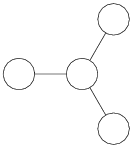User:Fropuff/Drafts/SO(8)
Draft in progress.
SO(8)[edit]

In mathematics, SO(8) is the special orthogonal group acting on eight-dimensional Euclidean space. It is a simple Lie group of dimension 28. The group SO(8) is special among the simple Lie groups in that it has the most symmetrical Dynkin diagram (shown right); possessing an S3 symmetry. This gives rise to peculiar feature of SO(8) — or more specifically, its covering spin group Spin(8) — known as triality. Triality is closely related to the fact that the two spinor representations of Spin(8), as well as the fundamental vector representation, are all eight-dimensional. For all other spin groups the spinor representation is either smaller or larger than the vector representation.
Like most special orthogonal groups SO(8) is not simply connected, having a fundamental group isomorphic to Z2. The covering spin group Spin(8) is the universal cover of SO(8), being both connected and simply connected. The center of Spin(8) is Z2×Z2 while the center of SO(8) is Z2. The quotient of SO(8), or Spin(8), by its center is the projective orthogonal group PSO(8).
Octonion multiplication[edit]
The groups SO(8) and its cover Spin(8) are intimately associated with the eight-dimensional octonion algebra, O. Indeed, many of the special properties of these groups can be seen as a consequence of this connection.
For every octonion a one can define the left and right multiplication maps:
These are real linear maps of O with the property that
where T denotes the transpose and I8 denotes the 8×8 identity matrix. Therefore, for any unit octonion x, the left and right multiplication maps are elements of SO(8).
The lack of associativity of the octonions means that LxLy is not necessarily equal to Lxy. That is, the set of all left multiplication maps is not closed under composition and does not form a group. One may, however, consider the group generated by the set of all left multiplications. Restricting to left multiplication by unit octonions, the resulting group must lie inside SO(8). In fact, it is all of SO(8). This is in contrast to the quaternion case where left multiplication by unit quaternions gives a three dimensional subgroup of SO(4) isomorphic to Sp(1).
Equivalent statements apply to right multiplications. That is, the group SO(8) is generated by either left or right multiplication by unit octonions. An arbitray element of SO(8) can always be written as a product of seven such multiplications. It follows that a right multiplication can be written as a product of seven left multiplications (or "seven lefts can make a right").
Autotopies and Spin(8)[edit]
An orthogonal autotopy of the octonions is a triple of orthogonal maps (α, β | γ) such that
for all x, y in O. The set of all orthogonal autotopies forms a group component-wise composition. One can show that all three maps in an orthogonal autotopy must have unit determinant. Therefore, there is a natural homomorphism from the orthogonal autotopy group to SO(8) given by
One can show that the kernel of this map is the two element group generated by (−I, −I | I). In fact, the orthogonal autotopy group of the octonions is isomorphic to Spin(8) and the above homomorphism is just the natural covering map.
Triality[edit]
The triality automorphism of Spin(8) lives in the outer automorphism group of Spin(8) which is isomorphic to the symmetric group S3 that permutes these three representations. The automorphism group acts on the center Z2 x Z2. When one quotients Spin(8) by one central Z2, breaking this symmetry and obtaining SO(8), the remaining outer automorphism group is only Z2. The triality symmetry acts again on the further quotient SO(8)/Z2.
Sometimes Spin(8) appears naturally in an "enlarged" form, as the semidirect product Spin(8)[[Image:Rtimes2.png|]]S3.
Root system[edit]
The SO(8) algebra is simple Lie algebra of type D4. The D4 root system is spanned by all integer vectors in R4 of length √2:
Weyl group[edit]
Its Weyl/Coxeter group has 4!×8=192 elements.
Cartan matrix[edit]












